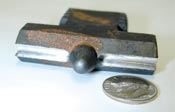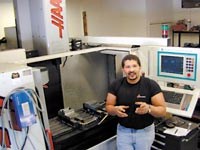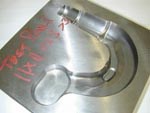What's Possible At 10,000 RPM
High-value work doesn’t have to demand a high-cost machine tool.
Share





Takumi USA
Featured Content
View More

Hwacheon Machinery America, Inc.
Featured Content
View More


Mark Mills knows as well as any other shop owner that when it comes to capital equipment, you get what you pay for. Machine tools at the high end in speed, precision, and capabilities can be essential to machining parts with the most aggressive quality and lead time requirements. Mr. Mills may have one or two such machines in his own shop one day.
But he’s not there yet.
For now, he relies on high speed machining to get the most value he can from his existing equipment. And thanks to the experience he’s developed at milling precise contours using light cuts taken at high feed rates, Mr. Mills has been able to make a lower-cost machining center competitive for complex 3D milling work against shops that do have more expensive machines. Along the way, he illustrates what is perhaps the most important thing that can be said about high speed machining: It doesn’t require an expensive machine tool.
His shop is Cherub Technologies of Elkhart, Indiana. As you might have guessed, the shop is small. It’s also young. In fact, with only two CNC machines, two full-time employees, and under two years in business, this company falls below the profile for the kinds of shops this magazine typically speaks to. However, there are many considerably larger companies that could benefit from the example of the work being done here. By realizing an effective high speed machining process, Cherub has considerably increased the value a standard machine can deliver. Where the shop started out machining only production parts, it now runs more profitable mold and electrode work on the same machine tool--—a vertical machining center with a top speed of 10,000 rpm.
Accelerating
Though the spindle doesn’t turn faster than this . . . to be accurate, the cutting tool sometimes does. Mr. Mills’ move into high speed machining began with a spindle speed increaser. Essentially a toolholder with a gearbox built in, the speed increaser (from Koyo Machinery, Plymouth, Michigan) lets the shop achieve tool rotation of 30,000 rpm at the expense of reduced torque.
He first used the speed increaser at a shop where he previously worked. It let him machine some simple production parts faster. However, when he opened his own shop, he wanted to pursue complex 3D milling work where control and programming technologies are important to realizing high speed machining. He started with a Haas Automation vertical machining center equipped with a high speed CNC from Creative Technology (Arlington Heights, Illinois), and programmed using CAM software for 3D machining from Sescoi USA (Southfield, Michigan). On this machine, he sometimes uses the speed increaser for milling fine details in electrodes. Later, he bought a second Haas VMC. This machine, with a standard CNC, he uses for production jobs. Here, the speed increaser is sometimes used for drilling.
In other words, the increaser has its place. However, this accessory is perhaps more significant for the way it lets him illustrate high speed machining to those who question whether high spindle speeds and feed rates can be used effectively. To show that they can, he drills a series of holes—perhaps in steel. First, he does the cutting at a more conventional spindle speed and the corresponding 2 or 3 ipm feed rate—parameters chosen only because a great many shops are accustomed to drilling in this range. Then, adding the speed increaser, he drills the same holes at 25 ipm, typically without any loss in the quality of the hole, and without any significant strain on a quality drill.
Experiments like this helped Mr. Mills himself grow accustomed to cutting fast. Watching the process perform effectively at unfamiliar speeds gave him the confidence to challenge other preconceptions as he went forward. This confidence proved particularly important for the die/mold work, where high feed rates are combined with light depths of cut to achieve near-net-shape machining in combination with a faster metal removal rate. Savings can come from reduced machining time, reduced bench work, and eliminating the need to use inserts for small details on complex molds. In die, mold and electrode work, high speed machining is not just a faster process, but a different process altogether.
And according to Mr. Mills, to realize such a process, “the first step is to overcome the barriers in your mind.”
As for how to put that sentiment into effect . . . that starts with the cutting tool, he says.
His advice: “Spend the money. Buy the best tooling you can.”
What The Tool Can Do
High speed milling at Cherub is performed with fine grain carbide end mills coated with titanium aluminum nitride (TiAlN). The tools can cost eight times as much as comparable cutting tools for the same work. However, if the tools can take the cut faster, with little or no loss in tool life, then they allow the machine to deliver more value per hour. To Mr. Mills, this makes the more expensive tools worth the investment.
In fact, how much faster these tools can cut may be understated. By carefully engineering his process so the cut is consistent—that is, so the tool sees no excessive changes in load throughout the cut—Mr. Mills finds he can often cut well beyond the recommended feed rate given by the tool supplier for milling at 10,000 rpm. It’s as if the parameters are generally chosen to be conservative, he says—perhaps based on the assumption that few shops will give the same attention he has given to achieving a steady and consistent cut.
Exceeding recommended cutting parameters is not advisable when this means exceeding rpm values established as safety limits for the tool. However, his experimentation typically involves feed rate instead. Particularly in cases where his top speed of 10,000 rpm falls squarely in the vendor’s recommended speed range, he feels justified in increasing the chip load until he finds out just how fast he can cut with a given tool.
The exercise is worth repeating for different vendors, he says. “Don’t assume that two tools are the same just because they have the same letters.” On the contrary, he has found that tool performance varies considerably from vendor to vendor. For tools that are used often, he says, test the same tool from several different suppliers.
Sometimes, his experimentation takes him into speed and feed regions where there are no recommended parameters. This is a common occurrence for him with TiAlN. The coating works best in hard metals or at very high speeds. However, when the shop cuts 45 Rc steel at 10,000 rpm, the process offers neither the hardness nor the speed. In these cases, Mr. Mills’ only choice is to turn up the feed rate. Thus he has discovered that the coated tools cutting softer metals sometimes perform well at high chip loads. (See the example in the figure below.)
Discoveries like this one have value to the tool supplier. Mr. Mills is engaged in helping his primary supplier (C. W. Vordenberge Co., Cincinnati, Ohio) develop a more detailed matrix of speed and feed recommendations. To this end, Mr. Mills monitors his own tool life and reports the data. With the more detailed matrix, the supplier hopes not only to extend cutting recommendations into uncharted ranges, but also to account for process factors affecting the consistency of the cut—factors like the ones discussed next.
Fast And Steady
When it comes to achieving long life with tools used in high speed machining, consistency is the most important requirement, says Mr. Mills. Even for aggressive cuts, it’s not necessarily the steady load that causes a tool to wear out, it’s the sudden and/or brief changes in load that the tool may encounter along the way. Eliminate just these fluctuations, and tool life can increase dramatically. However, achieving this consistency can take time, because several components of the process may have to be addressed. These include:
- The CNC. Cherub’s high speed control uses look-ahead functionality to prevent overshoots resulting from the tool feeding too fast though a sharp contour. Thus the CNC protects the tool against suddenly encountering a heavier load than intended.
- The toolholder. By holding the tool as close to centerline as possible, the toolholder can ensure that none of the tool’s flutes takes a deeper cut than the others. One day, Mr. Mills would like to rely on hydraulic toolholding or a shrink fit system to achieve concentric toolholding. For now, he gets good results using high quality collet toolholders to ensure a concentric grip.
- The tool path. Perhaps the most demanding process component on the list, the tool path must be analyzed again for each part. Unlike the previous two components, the cutting strategy is not a component that can be simply purchased once and put in place.
Mr. Mills’ CAM system helps him realize a consistent cut. The traditional approach to milling complex forms—feeding the tool back and forth in parallel passes—can lead to extreme variations in cutting load. The software Cherub uses includes a feature for milling the form using more complex tool paths that are calculated specifically to keep the load more even.
However, the software can only go so far. Also important is for the programmer to look carefully at the form of the workpiece, Mr. Mills says. Corners or other features where the finish milling tool is likely to encounter extra stock may merit an additional clean-up operation prior to the finishing cut. When the tool can’t last for the duration of the finish cut , it may not be the speed and feed rate, it may instead be just these regions of extra stock that cause the tool to fail too soon.
Time And Money
This approach—milling at high feed rates by combining high-end cutting tools with a consistent cut—allows the shop to realize high value for time on a low-cost machine. For graphite electrode work in particular. Mr. Mills assumes a high hourly rate.
But the operative word is “assumes,” he says. When he can, he leaves the rate unspoken, preferring simply to offer a straight quote for the job. The high hourly rate corresponds to a small number of hours at the machine, making the quote a bargain. Even so, customers have balked at the hourly figure.
He is still learning. When it comes to high speed machining, says Mr. Mills, there are barriers to overcome in his own mind . . . and there are barriers in customers’ minds, as well.
Postscript
Near the deadline for this article, Mr. Mills relayed this news that he had purchased a third vertical machining center—this one with 15,000 rpm. The decision had come suddenly, based on a large order the shop won. Right now, the new machine is used for batch production work, but it will become a die/mold machine as soon as he can afford to purchase his preferred CNC for it.
What’s possible at 10,000 rpm? For the shop that uses the speed effectively, it seems, there is the possibility of cutting even faster in the very near future.
Related Content
Lean Approach to Automated Machine Tending Delivers Quicker Paths to Success
Almost any shop can automate at least some of its production, even in low-volume, high-mix applications. The key to getting started is finding the simplest solutions that fit your requirements. It helps to work with an automation partner that understands your needs.
Read MoreQuick-Change Tool Heads Reduce Setup on Swiss-Type Turning Centers
This new quick-change tooling system enables shops to get more production from their Swiss turning centers through reduced tool setup time and matches the performance of a solid tool.
Read MoreWhere Micro-Laser Machining Is the Focus
A company that was once a consulting firm has become a successful micro-laser machine shop producing complex parts and features that most traditional CNC shops cannot machine.
Read MoreOrthopedic Event Discusses Manufacturing Strategies
At the seminar, representatives from multiple companies discussed strategies for making orthopedic devices accurately and efficiently.
Read MoreRead Next
Registration Now Open for the Precision Machining Technology Show (PMTS) 2025
The precision machining industry’s premier event returns to Cleveland, OH, April 1-3.
Read MoreBuilding Out a Foundation for Student Machinists
Autodesk and Haas have teamed up to produce an introductory course for students that covers the basics of CAD, CAM and CNC while providing them with a portfolio part.
Read More5 Rules of Thumb for Buying CNC Machine Tools
Use these tips to carefully plan your machine tool purchases and to avoid regretting your decision later.
Read More




































.jpg;maxWidth=300;quality=90)








.jpg;maxWidth=300;quality=90)









